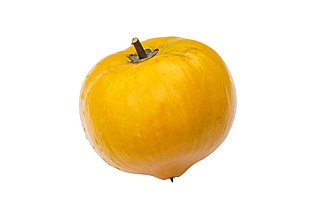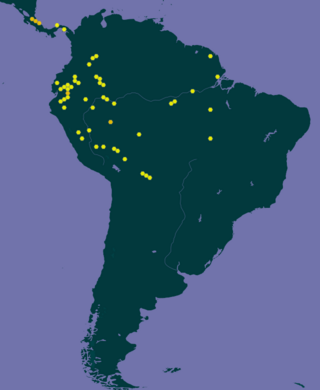
The Sapotaceae are a family of flowering plants belonging to the order Ericales. The family includes about 800 species of evergreen trees and shrubs in around 65 genera. Their distribution is pantropical.

Pouteria campechiana is an evergreen tree native to, and cultivated in, southern Mexico, Belize, Guatemala, and El Salvador. It is cultivated in other countries, such as India, Costa Rica, Brazil, the United States, the Dominican Republic, Australia, Cambodia, Vietnam, Indonesia, Sri Lanka, Nigeria, and the Philippines. The edible part of the tree is its fruit, which is colloquially known as an egg fruit.

Chaetocarpus is a plant genus of the family Peraceae, formerly Euphorbiaceae, first described as a genus in 1854. Chaetocarpus species are trees or shrubs. They are native to the Americas, Africa, and Asia. Some species are endangered.
- Chaetocarpus acutifolius(Britton & P.Wilson) Borhidi – Sierra de Moa in Cuba
- Chaetocarpus africanusPax – C Africa
- Chaetocarpus castanocarpus(Roxb.) Thwaites – SE Asia, Yunnan, Assam, Bangladesh, Sri Lanka
- Chaetocarpus cordifolius(Urb.) Borhidi – Cuba, Hispaniola, Jamaica
- Chaetocarpus coriaceusThwaites – Sri Lanka
- Chaetocarpus cubensisFawc. & Rendle – Cuba
- Chaetocarpus echinocarpus (Baill.) Ducke – Bolivia, Brazil
- Chaetocarpus ferrugineusPhilcox – Sri Lanka
- Chaetocarpus gabonensisBreteler – Gabon
- Chaetocarpus globosus(Sw.) Fawc. & Rendle – Jamaica, Cuba, Dominican Rep.
- Chaetocarpus myrsinitesBaill. – Bolivia, Brazil
- Chaetocarpus parvifoliusBorhidi – Cuba
- Chaetocarpus pearceiRusby – Bolivia
- Chaetocarpus pubescens(Thwaites) Hook.f. – Sri Lanka
- Chaetocarpus rabarabaCapuron – Madagascar
- Chaetocarpus schomburgkianus(Kuntze) Pax & K.Hoffm. – Colombia, Venezuela, 3 Guianas, NW Brazil

Pouteria is a genus of flowering trees in the gutta-percha family, Sapotaceae. The genus is widespread throughout the tropical Americas, with outlier species in Cameroon and Malesia. It includes the canistel, the mamey sapote, and the lucuma. Commonly, this genus is known as pouteria trees, or in some cases, eggfruits.

Sideroxylon is a genus of trees in the family Sapotaceae described as a genus by Linnaeus in 1753. They are collectively known as bully trees. The generic name is derived from the Greek words σιδηρος (sideros), meaning "iron", and ξύλον (xylon), meaning "wood."
Amburana acreana is a species of legume in the family Fabaceae. It is found in Bolivia, Brazil, and Peru. Its main threat is habitat loss.
Macrosamanea macrocalyx is a species of flowering plant in the family Fabaceae. It is found only in Brazil.
Micropholis resinifera is a species of plant in the family Sapotaceae. It is endemic to Brazil. It is threatened by habitat loss.
Pouteria decussata is a species of plant in the family Sapotaceae. It is endemic to Brazil.
Pouteria fossicola is a species of plant in the family Sapotaceae. It is found in Costa Rica and Panama.
Pouteria hotteana, the redmammee, is a species of plant in the family Sapotaceae. It is found in Haiti and Puerto Rico.
Pouteria longifolia is a species of plant in the family Sapotaceae. It is found in Bolivia and Peru.
Pouteria dominigensis is a species of plant in the family Sapotaceae. It is native to Cuba, Hispaniola, the Bahamas, and Florida. It is threatened by habitat loss.

Pouteria gardneri is a species of plant in the family Sapotaceae. It is a tree native to Brazil, Bolivia, and Paraguay. Its conservation status is insufficiently known.
Pouteria trigonosperma is a species of plant in the family Sapotaceae. It is found in Guyana and Suriname.
Zamia lecointei is a species of plant in the family Zamiaceae. It is found in Brazil, Colombia, Peru, and Venezuela. It is threatened by habitat loss.

Planchonella eerwah is a rare species of Australian rainforest tree in the family Sapotaceae. Common names include shiny-leaved condoo, black plum and wild apple. It is endemic to south eastern Queensland, with a restricted distribution and regarded as endangered.
Planchonella malaccensis is a tree in the family Sapotaceae. It is named after Malacca in Peninsular Malaysia.

Ormosia amazonica is a species of tree in the family Fabaceae native to the Amazon rainforest. It is naturally distributed in Brazil, Bolivia, Colombia, Costa Rica, Ecuador and Peru, in the Amazon Forest in Igarapó Forests. The species was first described by the Brazilian botanist of Austro-Hungarian origin Adolpho Ducke in 1922.

Mollia is a genus of flowering plants belonging to the family Malvaceae. It is within the Grewioideae subfamily, and the Grewieae tribe.









